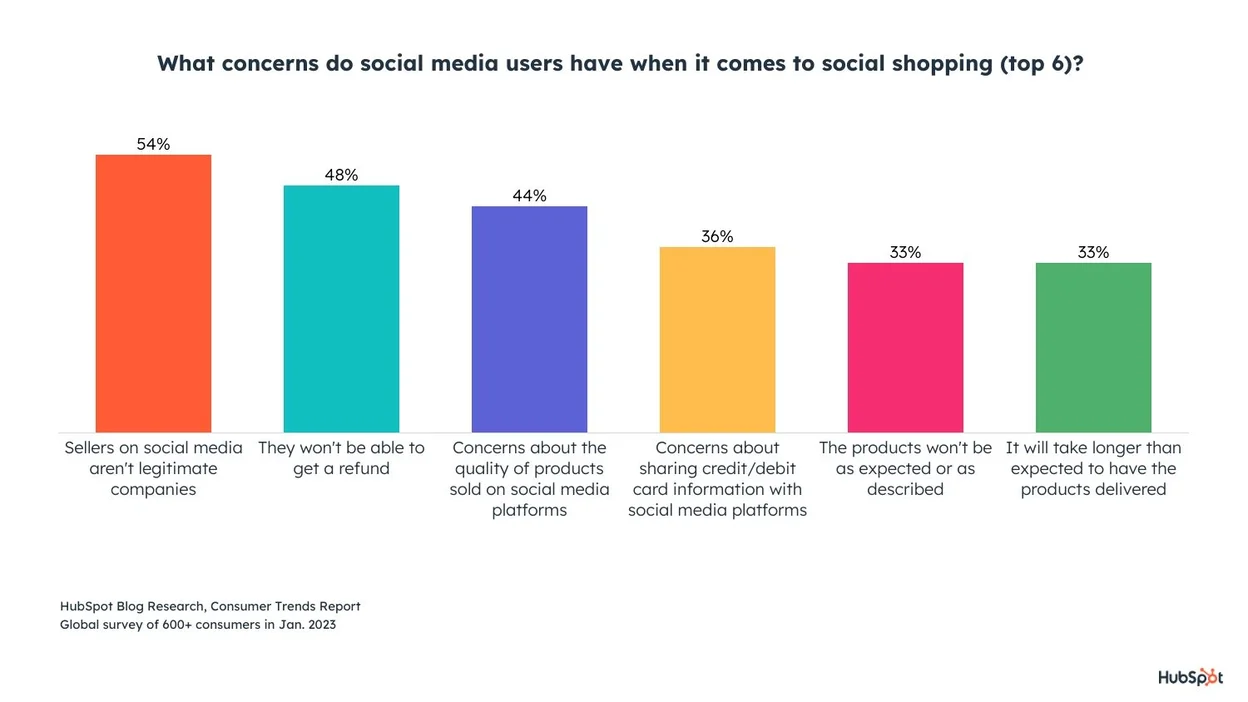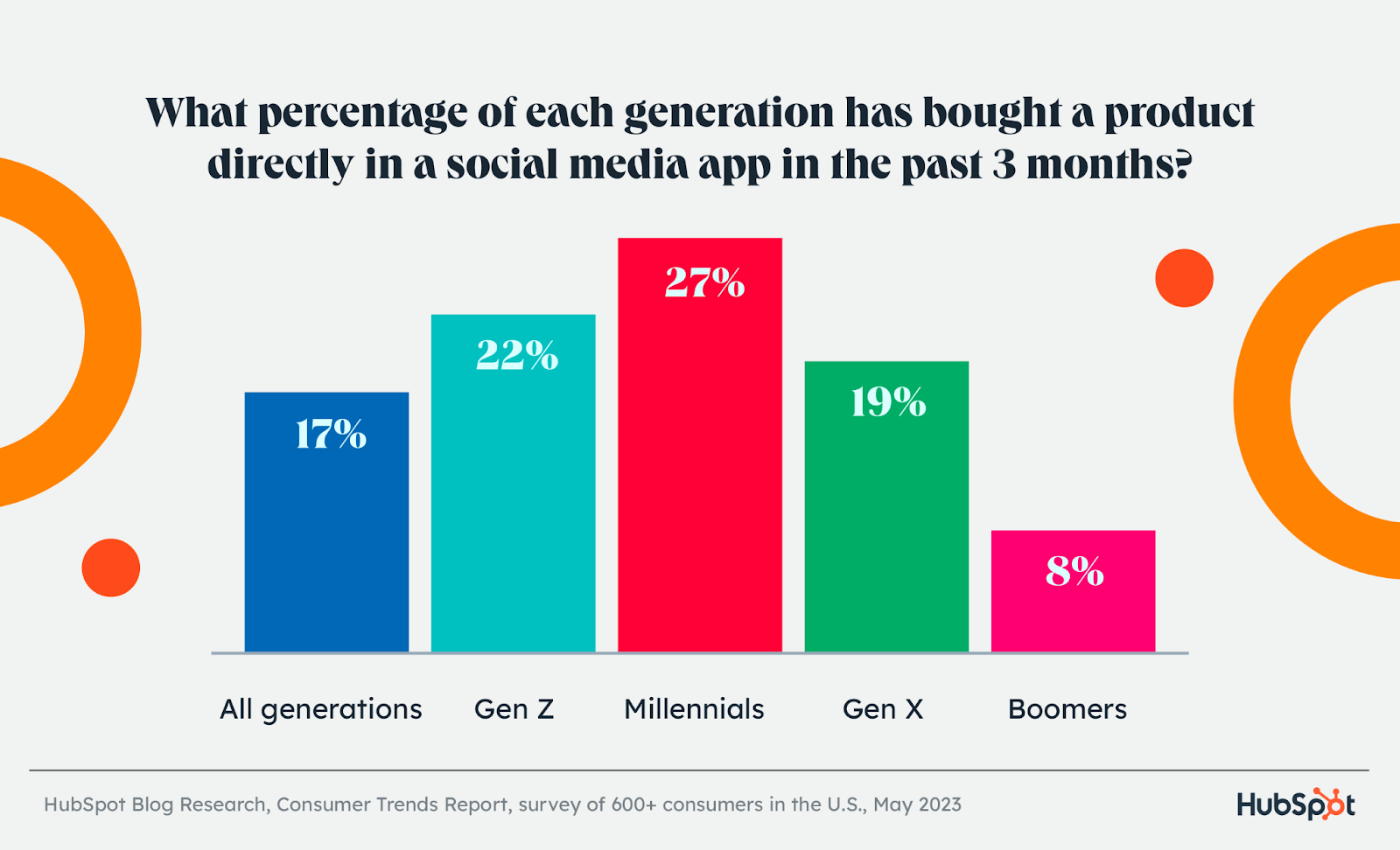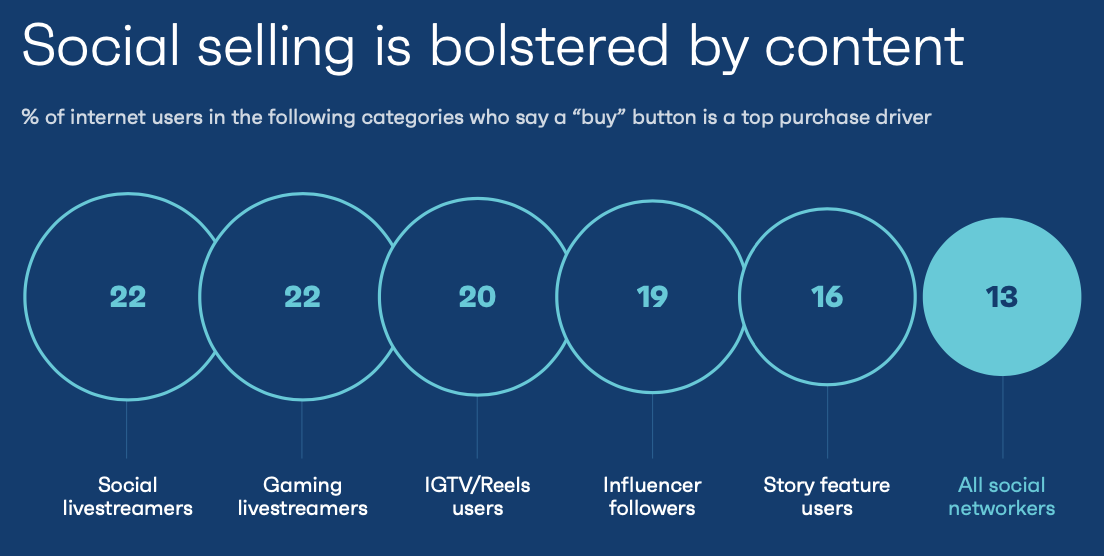81 Social Commerce Stats Marketers Should Know in 2023
Everyone wants a personalized and custom experience online, so it’s no wonder that social commerce has taken over the online shopping world.
Channels like Facebook, Instagram, Pinterest, Twitter, and WhatsApp already have thousands of businesses marketing on their platforms, and many have adopted shopping and payment functions that allow people to buy a product or service directly on the platforms.
Whether you’re looking for information to boost your social media shop or shape your online strategy, read on to discover social commerce stats that will help you understand the current market and learn best practices for attracting buyers and growing your business.
Social Commerce Stats for 2023
- General Social Commerce Stats
- Social Commerce Stats by Demographic
- Social Commerce Purchasing Stats
- Social Commerce Stats by Platform
- Social Commerce Stats for Business
General Social Commerce Stats
-
27% of consumers prefer to discover new products through social media over any other channel. (HubSpot)
- 41% of consumers have discovered a product on social media in the past three months, up 14% YoY. (HubSpot)
- 67% of consumers have already bought through social media platforms. (Wunderman Thompson, 2023)
- 53% of global consumers say they intend to shop more through social platforms in the future. (Wunderman Thompson, 2023)
- Global sales through social media platforms were estimated at 992 billion U.S. dollars in 2022. (Statista, 2022)
- Insider Intelligence predicts social commerce will be a $79 billion industry in the US by 2025. (Insider Intelligence, 2022)
- Chinese consumers spent $352 Billion on all social commerce in 2021. (McKinsey, 2022)
- Social commerce attracted investment from US companies at the start of the pandemic, in addition to online and mobile commerce. (Statista, 2021)
- 47% of social media marketers say their brand sells directly within social media apps. (HubSpot, 2023)
- Trust is a big factor for social shopping among social media users, as 54% are concerned that they companies selling on social media aren’t legitimate. (HubSpot, 2023)

- Just 41% of social media users feel comfortable making purchases on social media platforms and only 37% trust social media platforms with their card information. (HubSpot)
- 30% of eCommerce companies are already selling on social media, and 12% plan on selling through social media platforms in 2021. (Statista, 2021)
Social Commerce Stats by Demographic
- Over 1 in 5 Gen Z, Millennial, and Gen X social media users bought a product directly in a social media app in the past 3 months. (HubSpot, 2023)

- Consumers ages 18-54 prefer to discover new products on social media. (HubSpot, 2023)
-
TikTok is the most trusted platform for social shopping for Gen Z, but is the least trusted platform overall for all generations. (HubSpot, 2023)
- eMarketer estimates there will be 107M social buyers in the US by the end of 2023. (Statista, 2023)
-
85% of men who use Pinterest say that the platform feels personalized to them.(Pinterest, 2022)
-
80% of men on Pinterest agree that shopping here leads them to something unexpected that surprises and delights them (Pinterest, 2022)
- Thailand has the highest shares of social commerce buyers worldwide, followed by India and the United Arab Emirates. (Statista, 2022)
- In the US, nearly 36% of internet users are social buyers, which is approximately 90.2 million people. (Insider Intelligence, 2021)
- 41% of Gen Z and Millennials make an impulse purchase online every 2-3 weeks. (GWI, 2023)
- 73% of Boomers responding to a recent survey said they’ve made a purchase on Facebook in the past three months. (HubSpot, 2023)
- 51% of consumers in the US and UK use YouTube to research or find products to buy. (GWI, 2020)
Social Commerce Purchasing Stats
- $86.21 was the average value of online orders referred through social media during Q2 of 2022. (Statista, 2021)
- Nearly 27% of tablet visits to eCommerce websites resulted from social media platform referrals in Q1 of 2023. (Statista, 2023)
- Annual social spend will increase by $419 per buyer in the US over the next three years. (Insider Intelligence, 2023)
- People who have already made a social commerce purchase are 2X more likely to buy from a brand they’ve never heard of before than those who haven’t. (Accenture, 2022)
- Apparel and accessories are the largest categories for social commerce. (Insider Intelligence, 2021)
- People that use social media to access educational and inspirational content, like livestreams and stories, are eager to buy on social platforms. (GWI, 2020)
- 13% of social networkers say a “buy” button is one of the top purchase drivers. (GWI, 2020)

Social Commerce Stats by Platform
Facebook Social Commerce Stats
- Facebook is the most trusted social shopping platform overall. (HubSpot, 2023)
- Consumers say Facebook has the best in-platform shopping experience, and it’s the platform most consumers have used for in-app purchases in the past three months. (HubSpot, 2023)
- With 63.5 million buyers, Facebook ranks as the top social commerce platform in the US. (Statista, 2022)
- Facebook and Instagram are most used to learn about, discover, and buy fashion apparel products in the US. Over half of users said the content they see in their feeds results in a purchase. (Retail Dive, 2021)
- By Q1 of 2021, there were one million active Facebook Shops with over 250 million active participants every month. (AdWeek, 2021)
Instagram Social Commerce Stats
- Instagram is the third most-trusted social shopping platform, but consumers say ithas the second-best in-app shopping experience. (HubSpot, 2023)
- One retail brand using Instagram Shopping, Jane, reported 80% of total social sales came from the platform between July 2020 and February 2021. (Instagram, 2021)
- Instagram has 41M social buyers in the US. (Statista, 2022)
- Over 36% of B2B decision-makers use Instagram to find out information on new products or services. (Hootsuite, 2020)
YouTube Social Commerce Stats
- YouTube is the second-most trusted social shopping platform and consumers say it has the third-best in-app shopping experience. (HubSpot, 2023)
- 31% of survey respondents discovered a new product via YouTube ads in the last three months. (HubSpot, 2023)
- In Q3 of 2021, YouTube made its ads more shoppable by allowing video action campaigns on connected TVs. (Google, 2021)
- 51% of consumers in the US and UK use YouTube to research or find products to buy. (GWI, 2020)
TikTok Social Commerce Stats
- 45% of consumers have made a purchase within the TikTok app in the past three months. (HubSpot, 2023)
- Overall, TikTok is the least trusted platform for in-app purchases among consumers, but Gen Z actually prefers it. (HubSpot, 2023)
Pinterest Social Commerce Stats
- 27% of consumers have made a purchase within the pinterest app in the past three months. (HubSpot, 2023)
- Advertisers using mobile deep links on Pinterest see a 235% lift in conversion rates and 35% lower cost-per-acquisition. (Pinterest, 2023)
- Pinterest weekly users are willing to pay more—40% more per month in fact, than people on other social platforms. (Pinterest, 2023)
Social Commerce Stats for Business
- 47% of social media marketers say their brand already sells directly within social media apps. (HubSpot, 2023)
- 87% of sellers say that social selling has been effective for their business this year, and 56% say they’re making more sales through the channel this year compared to last. (HubSpot, 2023)SOCIAL MEDIA SALES AMOUNT IMAGE
- Over 36% of B2B decision-makers use Instagram to find out information on new products or services. (Hootsuite, 2020)
- 93% of US executives said their businesses are moving eCommerce efforts to social media. (Statista, 2021)
- In a 2021 survey, 86% of marketers and agency professionals in the US reported they were enabling shopping functions in their influencer marketing campaigns. The most common function is linking to the brand’s own website. (Statista, 2021)
- Advertisers anticipate spending $68 billion to promote their products on social networks in 2023. (Statista, 2023)
- The top benefits of social selling are precise audience targeting, a frictionless shopping experience, and the ability for brands to build and engage with their community (HubSpot, 2023)
- Around 80% of social media marketers say consumers will buy products directly within social apps more often than on brands’ websites or third-party websites like Amazon. (HubSpot)
- Over half of businesses selling on social media have under 100 employees, and about 20% make under $100K in revenue. (HubSpot, 2023)
![]()


![Download Now: The 2023 State of Social Media Trends [Free Report]](https://no-cache.hubspot.com/cta/default/53/3dc1dfd9-2cb4-4498-8c57-19dbb5671820.png)
